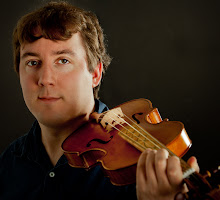This is the fifth and final post in a series that features the general principles important to those in the world of Early Music. Upcoming posts will talk about the finer details of actual performance that have shaped the current ideals of the Early Music sound world.
5. The use of temperament
While doing some reading on temperament for this post, I came across an article that warped my fragile little mind. The article, written in 1991, is basically an interview with six American composers, about the tuning systems that they use in their compositions. One of the composers was microtonalist Joel Mandelbaum. In response to the question "What tuning systems do you use?", he said:
"I use thirty-one-tone equal temperament, which gives the best approximation to just intonation through prime seven and prime eleven. I started in nineteen-tone equal temperament, using Yasser as a starting point, along with a bit of the golden-tone theory of Thorvald Kornerup. I might go back to nineteen for a piece or two, but I'm quite happy with thirty-one."
If I had been the interviewer, I would have choked on my coffee. Yet this analytical, mathematical description of a temperament is the unfortunate reality of dealing with tuning systems, at least to those who are in the business of looking at it that way.
The idea of being able to play with perfect intonation is a scientific impossibility, as musicians and theorists have known for centuries. The problem (primarily for fixed-pitch keyboard instruments) arises from the impossibility of dividing up the octave into smaller intervals that remain pure throughout all 24 major and minor keys. The different mathematical methods for dividing up the octave result in what are known as temperaments. For several centuries, many different temperaments were in use, as theorists and musicians argued and fought over what the ideal temperament should be. The temperament that emerged victorious is the one in worldwide use today (outside of the early music scene): equal temperament.
Equal temperament is, mathematically, the simplest solution to the problem: it divides the octave into 12 identical semitone intervals. This seems sensible, but has several drawbacks. For instance, since equal temperament widens all the major thirds slightly beyond perfect, not a single chord in any key on the piano is exactly in tune. More importantly, it eliminates the difference between the expressive sound of different keys, such as A Major and C-sharp Major. Music theorist and composer Andreas Werckmeister said in 1697: "in the future ... it will be just the same to play an air in C-sharp as in C." His prediction came true.
As wide-spread as equal temperament has become, it is of course not the only temperament available for keyboard instruments. Performers of early music aim to find the most suitable temperament for any given piece, depending on its key and chromaticism. One of the most important temperaments for early music is mean-tone, which has many different variants. In general, this temperament slightly narrows the perfect fifths, then finds various ways to plug perfect major thirds into the keyboard - the result being that some keys sound amazingly resonant and some keys sound hideously out of tune. This is fine for a lot of music that doesn't venture into keys with multiple sharps and flats like B Major and G-flat Major. But in pieces that do exploit foreign keys, the difference between 'good' and 'bad' can be heard quite dramatically: take, for example, Louis Couperin's Pavane in F-sharp minor, in a recording by Skip Sempe on a harpsichord tuned in a mean-tone temperament. While some keys sound wonderful, there is a seriously funky moment around 1:35/1:36, just before the music repeats back. Here we have reached C-sharp Major, and the major sixth between G-sharp and E-sharp is noticeably out of tune, in a way that the harpsichordist lovingly highlights.
Another important type of temperament that has many variants is the well-temperament, the name of which is familiar to everyone from Bach's two books of preludes and fugues in all the major and minor keys, the Well-Tempered Clavier. This is not, as some people thought and perhaps still think, the same as equal temperament. Well-temperament simply means any temperament that can be used across all keys in a way that disguises any noticeably bad areas. Whereas mean-tone specifically favours the most common keys (thereby creating cringe-worthy dissonances in more remote keys), well-temperament aims to balance the dissonances across all 24 keys, without necessarily equalising them. In this way, unique characteristics and sonorities of different keys can be preserved, without any one key being overly harsh.
Many people think that the 'ideal' temperament to strive for is just temperament. While tuning individual triads justly, according to a perfect fifth and a pure major or minor third, works very well in string quartet playing or a cappella vocal music, to play or sing continuously through a piece of music in just temperament is to arrive at a very strange result. Listen to this version of Bach's well-known C Major Prelude and you'll hear what I mean.
Being kept in place by a tempered keyboard or by the fixed open strings of a violin is perhaps not as bad as we might think.
Temperament is essentially about compromise. From the perspective of a violinist and performer, rather than a theorist, my experiences with temperament since entering the world of early music have still allowed quite a lot of flexibility, despite what keyboard temperament I'm supposed to fit with. No matter what the temperament is, I still have the freedom to adjust my intonation as pure as possible, depending on the context and the style of the accompaniment. And it's not just string players that can adjust - even a harpsichordist has flexibility. When I performed with the Wallfisch band a little over a year ago, the harpsichordist, in the middle of each concert, spent just a few minutes with his tuning lever to change all the sharps on the instrument to flats, since the music we were about to play was predominantly in flat keys. The science behind temperaments may make them seem like a binding contract, but in practice, musicians have a lot of leeway.



No comments:
Post a Comment